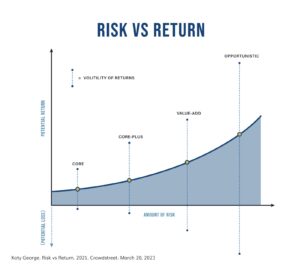“Don’t wait to buy real estate, buy real estate and wait.” – Will Rogers (actor)
If we take Mr. Rogers’ quote at face value, the best time to buy real estate is always now (I don’t share that opinion, but it’s probably not precisely what he intends by the quote). That begs the question of what type of property one should purchase. Continuing where we left off in Part 3 of this series, let’s not waste any time getting right into the many commercial real estate property types. Here we go!
Eight is great
As mentioned last time, here’s an overview of the eight main property types (heavily relying on Reonomy and DealPath as two resources that generally agree on these), along with common examples/sub-types. The goal here is to show at a high level the impressive number of different commercial property classifications, which will set the stage for us to eventually focus on select subsets:
- Multifamily: Duplexes/triplex/quadruplex, garden apartments, mid/high-rise apartments, walk-ups, student housing, senior living
- Office: Class A, B, or C, based on “age, condition, location, and more”; may be low/mid/high-rise, in a central business district (CBD) or suburban
- Industrial: Heavy manufacturing, light assembly, bulk warehouses, flex warehouse/industrial (mixed use)
- Retail: Strip malls & shopping centers, community retail centers, power centers (large anchor tenant, often near a highway), regional malls, out parcels (e.g., a restaurant that resides out in a mall parking lot)
- Hotels & Hospitality: limited-service hotels (no room service or restaurants), full-service hotels, extended-stay hotels, resorts
- Mixed Use: Combinations of the aforementioned types; common examples are having apartments upstairs from retail/office space or downtown high-rises with several businesses on the ground level and residences above.
- Land: Greenfield (undeveloped/agricultural), infill (in cities – formerly developed but now vacant area), brownfield (land that “previously held commercial buildings”)
- Special Purpose: “Amusement parks, bowling alleys, parking lots, theaters, zoos,” schools, churches, and many more
After investing in real estate on behalf of clients for about the last half of my advisory career, I’ve learned (among other things) that all property types aren’t created equal. Given that we want alternative investments that can enhance a portfolio’s overall income/volatility/return characteristics, I prefer avoiding more cyclical types or those with potentially outsized downside risks. We also know that There’s No Free Lunch; thus, we must accept that attempting to reduce/avoid downside tail-risk will naturally trim off some of the upside “risk” scenarios as well (I use risk in quotes here because no one calls extreme upside scenarios “risk” – they call it “outsized return”).
Our goal is to hit many singles, doubles, and even some triples in our core Alts allocations. We don’t need to hit home runs to win this game, which also (hopefully) means we can avoid striking out. Thus, some real estate types will be a natural fit as part of one’s portfolio core, while others are better for an opportunistic role. It all comes down to risk/return/income characteristics and the drivers of those factors. Thus, what I’m going to try to do from here (I think) is look at real estate development across a spectrum to help understand what expectations we can reasonably set.
Start at the beginning…
Before there were buildings, there was only land. And if we contemplate what type of real estate project has the longest runway, it would be an airport…
Seriously, though, the most long-term project plans, in terms of creating something out of nothing, are when someone takes raw land and develops it into a finished commercial building that they then lease and manage. In that case, they are starting with what may be a green field and making their vision come to life; this is literally called “greenfield” development! Alternatively, a project can begin with what’s called a brownfield, which is land that has previously been built upon.
It’s debatable which of the two (greenfield or brownfield development) involves more risk or which has the longer timeline to completion, but I think it’s safe to say that answer varies on a project-by-project basis. A greenfield is essentially a clean slate, but the land may need to be cleared and reconfigured/graded to get to the starting line for construction. Then, of course, a problematic permitting process can kill a project before it even starts. And essential connections for power, water, gas, and sewage can all be projects in and of themselves, depending on the location. Conversely, in a brownfield project, the utilities and permitting aspects may be solved beforehand (not a given). Moreover, the plan may require total demolition and potential environmental surprises tied to the existing site. Thus, neither is without its challenges, and that’s before we even consider constructing the new building.
…and build from there
With the above in mind, ground-up development – whether greenfield or brownfield – involves potential risks and rewards that could be eliminated from real estate projects with a more limited scope (which we’ll cover in upcoming editions of Alt Blend). Unsurprisingly, it falls squarely within the “opportunistic” real estate investing category, which will serve as one end of our risk/reward spectrum. As shown in the below graphic from Crowdstreet, that spectrum ranges from the more conservative category of core real estate (lowest risk/reward) to core-plus, value-add, and, finally, opportunistic (highest risk/reward).

That’s a reasonable stopping point for today, but we’ll learn more about these categories and what types of projects fall into each when we reconvene in Part 5 of this series.
Until next time, this is the end of alt.Blend.
Thanks for reading,
Steve


